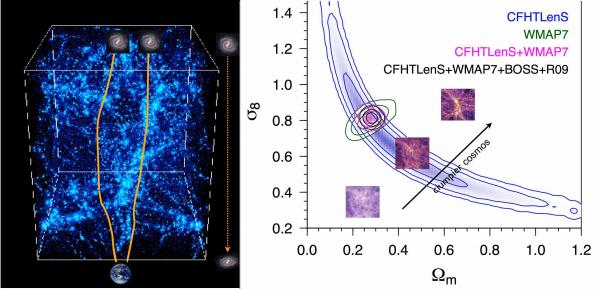In a review article in "Reports on Progress in Physics", Martin Kilbinger of Astrophysics Department - AIM Laboratory at CEA-IRFU presents a comprehensive assessment of the results obtained from observations of the cosmic shear in the last 15 years. The cosmic shear effect has been measured for the first time in 2000. This effect is a distortion of the images of galaxies under the effect of gravity of the intervening clumps of matter. It allows to map the dark matter but also to determine how dark energy affects the cosmic web. The article highlights the most important challenges for turning cosmic shear into an accurate tool for cosmology. So far, dark matter has been mapped for only a tiny fraction of the sky. Future observations, such as those of the future space mission Euclid, will cover most accessible regions of the sky. The review presents the progress expected from these potential future missions for our understanding of the cosmos.
 |
See the presentation by Martin Kilbinger |
Most of the matter in the universe is not visible, but "dark". We cannot directly see dark matter, so we have to look for indirect ways to study it. Dark matter acts on light via the gravitational force. Light from distant galaxies on its way traveling to us is bent by dark-matter structures, and as a result images of galaxies are slightly distorted. These distortions are called cosmic shear, and we use them to map the distribution of dark matter in the cosmos. And from the evolution of those structures, we can deduce properties of dark energy.

Left : Illustration of light traveling through the clumpy universe. The bending of the light causes the two galaxies to be distorted when seen by us on Earth. The clumpier the cosmos is, the stronger are the distortions.
Right: Measurement of the matter density (Ωm) and the "clumpiness" of dark matter (σ8). The contour lines indicate the allowed regions by the present surveys. The arrow shows the direction in which the structures in the cosmos get clumpier. Credits CEA-SAp
The review article covers cosmic shear observations over the last 15 years. It presents results on dark matter and its relation to galaxies, dark energy, and tests of Einstein's Theory of General Relativity.
The review concludes with a discussion of the potential of cosmic shear for cosmology in the coming years.
So far, dark matter has been mapped for only a tiny fraction of the sky. Upcoming and future observations will cover most of the accessible regions on the sky, and cosmic shear has a great potential for advancing our
understanding of fundamental physics, exploring the origin of the recent accelerated expansion of the Universe, and distinguishing between dark energy models and theories of modified gravity.
Contact : Martin KILBINGER
Publication :
"Cosmology with cosmic shear observations: a review"
Martin Kilbinger 2015 published in Reports on Progress in Physics, vol 78, 086901 (doi:10.1088/0034-4885/78/8/086901), for an electronic version
See also : "Inventory of the Dark Universe", 11 April 2013
"Concentré d'Univers avec la caméra MegaCam", 26 Octobre 2012
" Feu vert pour la mission spatiale Euclid", 20 Juin 2012
" Fresque cosmique - Carte de la matière noire", 7 Janvier 2007
Redaction: M. Kilbinger, J.M. Bonnet-Bidaud
• Structure and evolution of the Universe › Evolution of the large structures and galaxies Thèmes de recherche du Service d'astrophysique Structure et évolution de l'Univers
• Department of Astrophysics (DAp) // UMR AIM
• Cosmology and Galaxy Evolution
• Euclid
